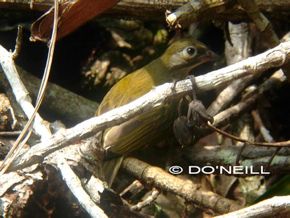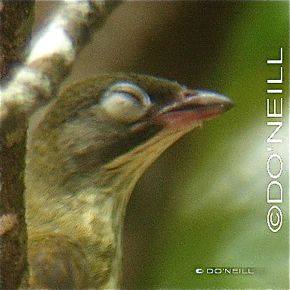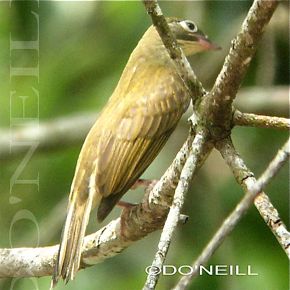“The Malaysian Honeyguide (Indicator arachipelagicus) is a rare little known, rather overlooked resident and near-threatened species of mainly lowland plains forest edge habitat. Being one of the 15 species of honeyguides found in the world, a recent find in Borneo is thus of much interest to the local and international bird community. Its habitat puts this species at greater risk to extinction.
“A short list of Borneo’s isolated sightings, mainly adults may be found in ‘The Birds of Borneo’ by Bertram E. Smythies for further reference.
“A fresh, looking juvenile Malaysian Honeyguide became the latest addition to the documented list and first juvenile known to be photographed in the wilds of Borneo at Similajau National Park, Bintulu, Sarawak on 27th September 2011.
“The olive-brown looking bird of bulbul size was first observed to be gleaning for insects over an old oil palm stump. What caught my attention was, the bird’s white goggled looking eye and its finch looking beak that didn’t look right for any bulbul species I know.
“The bark- gleaning insectivore then flew to grass ground, headed for a decayed heap of cut tree branches and foraged further. The first opportunity shot came at 2.20pm (left).
“No calls heard from the juvenile bird. An adult, territorial male would otherwise have sounded endlessly like a ‘meow’ of a domesticated cat, in interesting pecking order.
“Two highly respected authoritarians-specialists on Bornean birds were consulted to bring more light to this species as my findings ended no match with any guide books at hand.
“This feeding behavior on the ground was quoted by Dr. David Wells to be a new observation. Full description of a Malaysian Honeyguide can be read at the said author’s book – ‘The Birds of Thai-Malay Peninsula Vol: 1.’
“The tubular looking bird then flew and perched onto a nearby skeletal tree branch about ten meters above for a few shut eyes. It then flew off towards the forest edge. Total observation period was just over four minutes.
“Of much interest and provision of documentary images to the experts, lets read and share what each author had their say of the bird’s eyelids and plumage’s pattern age:-
“To quote Dr. David Wells: ‘I have never seen one with such a pronounced bare eyelid ring before or with such distinct striping from chin down’ (above).
“To quote Quentin Phillipps (author of Phillipp’s Field Guide to the Birds of Borneo): ‘A very unusual and interesting set of photos. This is probably a young juvenile bird as indicated by the heavy eyelids’ (below left).
“Of further interest to this species that we know so little, apart from their names derived from habits of some African counterparts that lead men to harvest nests of wild bees, it is hypothetically mentioned in guide books that brood chicks are parasitic and Brown Barbets (Calorhamphus fuliginosus) are top host suspects. (Wax and bees have been found included in their diet but the Asian species don’t behave as guides this way)
“Why the heavy eyelids/prominent bare eyelid ring found only in juveniles? Here is a comparison image of a new fledgling Brown Barbet taken five days earlier on the 22nd September. The chick was observed to be perched and napping after being fed by parent. The fruiting fig tree was about 300 meters from where the juvenile Malaysian Honeyguide was first located (above right and left).
“Don’t their thick eyelids look similar? Possible they came from the same nest – a hypothetical coincidence?
“Quentin Phillipps’ guide book of Borneo has an interesting read on barbets as brood hosts to parasitic honeyguide chicks. To add further, this is what he has to say hypothetically: ‘I suspect the young honeyguide mimics a young barbet to avoid being evicted from the nest by barbet parents. As far as I am aware, there is no definite proof of the Brown Barbet being the brood host to the honeyguide but several suspicious observations indicate that this to be the case and my observation is a further indication.’
“So, until an extremely lucky bird-photographer comes along to photo-document a chick feeding shot of parental Brown Barbet to a honeyguide chick; or three knowledgeable birders of repute to confirm such a sighting, the hypothesis remains.
“This observation in photography however, brings new light to further indicate breeding periods, physical features of newly fledged honeyguide juveniles never seen before and a hypothetical step further, to home in their ‘cuckoo’ behavior as parasitic broods to barbet hosts.”
Submitted by: AvianWriter Daisy O’Neill Penang Malaysia, in consultation with Dr. David Wells and Quentin Phillipps
Optics used: Fieldscope ED82X30+Digital camera P3. Binoculars: 8×32
Copyright Images: Daisy O’Neill Bird Conservation Fund















3 Responses
very interesting notes. I had read before that honeyguides, unlike cuckoos, will take care of the juveniles, they mainly rely on the host to incubate and raise the young birds for them, but cuckoos generally will not care about the offsprings once they completed the egg laying process.
very interesting observation, not only the cukcoo, the honeyguide also practises brood parasitism.
so is the cuckoo duck, so named for its brood parasitism, likely few more examples but they are usually not found in Malaysia so I didnt spend all time remembering all of those cases.